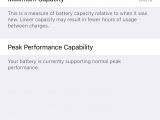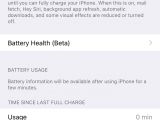Apple has finally shipped iOS 11.3 earlier this week, and one of the biggest changes is the addition of a battery diagnosis feature that lets users find out if the battery of their iPhones needs servicing or not.
This improvement is part of a months-long saga that started in December after Apple officially acknowledged that it slowed down some older iPhone models on purpose in an attempt to prevent unexpected shutdowns.
Apple said this was necessary because devices with degraded batteries could experience issues like these unexpected shutdowns even when the battery isn’t depleted yet, so reducing performance of the processor was a way to ensure the same battery life despite these hardware problems.
While everything sounds good at first, the changes that Apple made are believed to have pushed some iPhone users to newer-generation models, a move that is often referred to as planned obsolescence and which is not only unfair for customers, but also illegal in some markets.
As a result, Apple launched a battery replacement program with a discounted price from $79 to $29, promising to also ship features that would help users determine if their iPhone battery is degraded and to even disable the slowdown should it already be enabled.
These new features arrived with iOS 11.3, though Apple appears to be playing the safe card here, as it marks them with a beta tag, probably to signal that some things might not work exactly as expected.
Checking how worn-out the iPhone battery takes just a few seconds. On the iPhone, launch Settings and follow the next path to see your score:
Settings > Battery > Battery Health (Beta) > Maximum Capacity
The percentage in the Maximum Capacity field is the one that says everything about your iPhone battery. Previously, you could check the battery health level by contacting Apple Support, either through the company’s website or directly on Twitter at @AppleSupport. After a short benchmark, the engineer could tell you if the battery needed servicing or not, though they never provided any specifics on how degraded the battery is. In my case, @AppleSupport said the battery was “OK” and that it didn’t need any repairs. In iOS 11.3, the Maximum Capacity on my iPhone 6s Plus is 96%.
Depending on this Maximum Capacity score, you can determine whether you have to replace the battery or not. Apple says that once your battery dropped below 80%, this performance throttle kicked in to make sure no unexpected reboots occurred.
“Your battery is designed to retain up to 80% of its original capacity at 500 complete charge cycles,” Apple says on its website.
So technically, once capacity drops to 80% or lower, you either need the performance throttling that Apple enabled without telling anyone or get a new battery in order to prevent any issues with your device.
Apple itself has added short descriptions to each of the options in the new battery section. For example, maximum capacity “is a measure of battery capacity relative to when it was new. Lower capacity may result in fewer hours of usage between charges.”
The second option available here indicates how your device performs and if CPU throttling is necessary. As you can see in the screenshot here, my iPhone 6s Plus was rated at “Peak Performance Capability,” with this diagnosis telling me that my “battery is currently supporting normal peak performance.”
For what it’s worth, Apple’s battery replacement program for $29 servicing is available throughout the year and we’re getting signals that the company is close to resolving inventory issues plaguing batteries in its stores. In other words, if you were waiting to replace your degraded iPhone battery, now could be a good time to get in touch with your Apple Store and make an appointment for a replacement.

 14 DAY TRIAL //
14 DAY TRIAL // 

